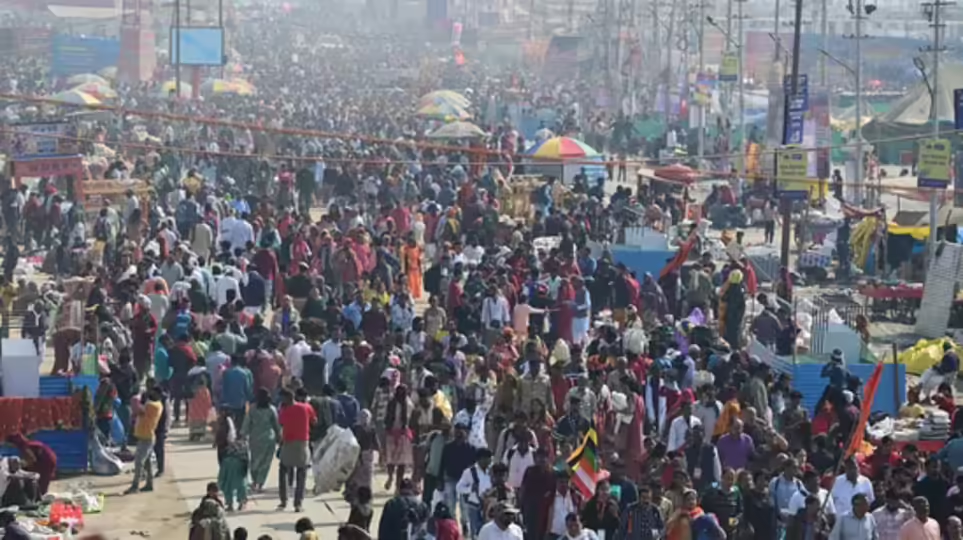Prayagraj’s Dual Strategy for Maha Kumbh Crowd Management: AI Monitoring and Traffic Bans
Tue, 25 Feb 2025

Authorities in Prayagraj have announced a phased vehicle ban across key routes to manage the anticipated influx of 120 million pilgrims during the ongoing Maha Kumbh Mela, one of the world’s largest religious gatherings. The restrictions, effective from 4:00 PM on Tuesday and extending to 6:00 PM onwards on subsequent days, target private and commercial vehicles entering or exiting the Kumbh Mela area. Emergency services, including ambulances, fire tenders, and law enforcement vehicles, remain exempt from the ban. The decision follows consultations with traffic experts and local administration officials to address congestion risks along arterial roads connecting the mela grounds to central Prayagraj. The vehicle ban applies to a 12-kilometer radius around the Kumbh Nagri, covering critical junctions such as the Sangam Marg, Allahpur Crossing, and Zero Road. Traffic police have identified these zones as high-risk areas due to historical footfall patterns observed during previous editions of the event. According to Prayagraj District Administration, the restrictions aim to reduce vehicular density by approximately 40% during peak evening hours, aligning with the surge in pilgrim movement post-sunset. Real-time data from GPS-enabled traffic monitors indicates that evening hours between 4:00 PM and 10:00 PM account for nearly 60% of daily congestion during large-scale events. To mitigate disruptions, authorities have operationalized 18 alternative routes diverting traffic away from the mela vicinity. These pathways connect peripheral areas like Phaphamau, Jhunsi, and Daraganj to major highways, including National Highway 19. Over 45 temporary parking lots, with a combined capacity of 150,000 vehicles, have been established within a 5-kilometer radius of the event site. Shuttle services, comprising 500 electric buses and 1,200 auto-rickshaws, will ferry pilgrims from parking zones to designated entry gates at 15-minute intervals. The regional transport office has additionally deployed 1,000 extra buses across Uttar Pradesh to accommodate interstate travelers. Violations of the vehicle ban will incur fines ranging from ₹2,000 to ₹5,000, with repeat offenders facing possible vehicle impoundment. Traffic checkpoints equipped with automated license plate recognition systems have been installed at 30 strategic locations. The Prayagraj Police reported issuing 850 penalties during a trial run of the restrictions last week, highlighting strict enforcement protocols. Surveillance infrastructure has been scaled up to monitor crowd dynamics, with 1,200 high-resolution CCTV cameras integrated into an AI-powered command center. The system, developed in collaboration with tech firms, analyzes live footage to predict congestion hotspots and allocate security personnel accordingly. Facial recognition software has also been deployed to trace missing persons, leveraging a database of over 100,000 registered pilgrims. Health and sanitation measures include 250 medical camps staffed by 3,000 healthcare workers and 450 ambulances stationed across the mela grounds. Water quality sensors have been installed at 50 points along the Ganga River, with real-time data shared via public announcements to ensure safe ritual practices. Over 20,000 portable toilets and 15 waste processing units, capable of handling 200 metric tons of daily waste, have been set up to maintain hygiene standards. The Prayagraj administration has coordinated with 45 NGOs and 12 international agencies to streamline disaster response protocols. Historical data from the 2013 Kumbh Mela, which saw 100 million attendees, informed current crowd management strategies, including staggered bathing schedules and digital ticketing for restricted zones. Meteorological updates from the Indian Meteorological Department (IMD) are being broadcast hourly to guide pilgrims amid fluctuating weather conditions. Local businesses, including 5,000 licensed vendors, have been relocated to designated commercial zones equipped with solar-powered lighting and waste disposal units. The district trade association estimates a 30% increase in daily sales compared to non-event periods, driven by pilgrim footfall. Temporary shelters accommodating 500,000 individuals have been erected, with provisions for free meals and drinking water at 200 distribution points. The vehicle ban and allied measures will remain in effect until the conclusion of the Maha Kumbh on March 8, with daily reviews by a 25-member task force. Authorities emphasize that the restrictions are not punitive but preventive, prioritizing pedestrian safety and operational efficiency. Pilgrims are advised to follow real-time updates via the official Kumbh Mela mobile app, which has recorded 2 million downloads since its launch in January.
